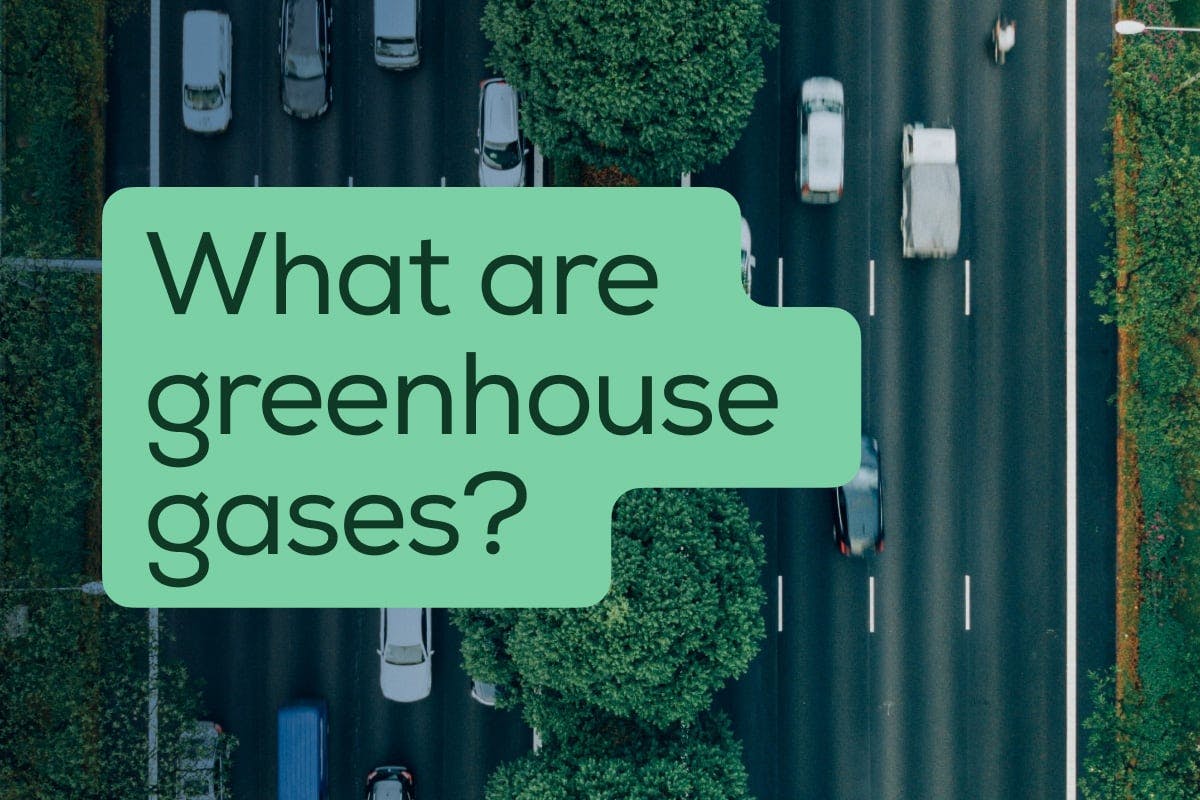What Are Greenhouse Gases? Sources, Problems, and Solutions
Last edited

Author
Andrew Blok
Electrification and Solar Writer and Editor

Editor
Ryan Barnett
SVP, Policy & New Market Development

Climate change is a serious and growing problem, and greenhouse gases are its main cause. These gases have always been present in our atmosphere and help make Earth a livable planet, but in the last few hundred years, fossil fuel use has raised atmospheric concentrations and warmed the planet.
But what exactly are greenhouse gases, how do they warm the planet, and how can we reduce the amount we produce and avoid the worst effects of climate change? We take a closer look below.
See how much you can save with home energy changes
Greenhouse Gas Definition
What are greenhouse gases? Greenhouse gases absorb and emit heat energy, trapping it in the atmosphere. This phenomenon of trapping solar radiation and absorbing infrared radiation is known as the greenhouse effect — a term inspired by the greenhouses that can sustain life during colder months by absorbing radiant energy from the sun and retaining it within a glass enclosure. Thus, the greenhouse effect helps our planet stay warmer than it would be without an atmosphere.
To a certain extent, greenhouse gases benefit the planet by creating a layer of protection that holds onto heat instead of allowing it to escape from our atmosphere. Without greenhouse gases, life would not be possible. The planet's temperature would drop to below 0˚F, creating an inhospitable environment for plants and animals to survive.
However, the opposite is also true: If greenhouse gas concentrations in the atmosphere get too high, the planet can become too warm. This is the leading cause of climate change.
Global Warming Potential of Greenhouse Gases
Greenhouse gases impact the planet in different ways, depending on their ability to absorb energy (their "radiative efficiency") and how long they remain in the atmosphere (their "lifetime").
A measurement called the global warming potential helps compare the climate impact of different greenhouse gases. The global warming potential measures how much energy the emission of one ton of a gas will absorb, compared to the emission of one ton of carbon dioxide (CO2) over a given period, usually 100 years.
The higher the global warming potential, the more that gas contributes to global warming compared to CO2 over that same amount of time. By creating this common unit of measurement, analysts and policymakers can create accurate emission estimates for the various gases, and compare carbon emissions and reduction opportunities across different sectors.
| Greenhouse gas | Global warming potential |
|---|---|
| Carbon dioxide | 1 |
| Methane | 27-30 |
| Nitrous oxide | 273 |
Credit: US EPA
Examples of Greenhouse Gases
Since the beginning of the Industrial Revolution, generally considered the mid-18th century, humans have released more greenhouse gases into Earth’s atmosphere than needed to maintain a healthy greenhouse effect. These increased greenhouse gases come from manufacturing, transportation, and agricultural practices. Even worse, industrial actions have led to the creation of new greenhouse gases that only hurt the atmosphere, which has increased the speed of global warming.
Carbon dioxide
Carbon dioxide (CO2) is the most common greenhouse gas, making up nearly 75% of all greenhouse gas emissions.
Atmospheric CO2 is released through natural events such as volcanic eruptions and respiration but has risen to harmful levels in the atmosphere in the last 200 years. This increase in CO2 concentrations can be traced primarily to burning fossil fuels.
The Scripps Institution of Oceanography and the National Oceanic and Atmospheric Administration have recorded CO2 levels in the atmosphere at the Mauna Loa Observatory in Hawaii since 1958. In that time, they’ve risen from less than 320 parts per million to more than 420.
Reducing our reliance on fossil fuels and switching to clean energy can help reduce carbon dioxide emissions.

Credit: NOAA
Methane
Methane (CH4) occurs naturally through decomposition. As organic matter decomposes, it releases methane into the atmosphere, a process that has been happening for millions of years.
The increase in atmospheric methane over the past two centuries comes from human activities such as fossil fuel production, cattle farming, rice production, and rotting organic matter in landfills. Unfortunately, while methane only makes up around 17% of greenhouse gases, it’s much more harmful than CO2 as its global warming potential is about 27-30 times higher.
Reducing fossil fuel and meat consumption and diverting waste from landfills can reduce methane emissions.
Nitrous oxide
Nitrous oxide (N2O) is another naturally occurring greenhouse gas that has recently spiked out of proportion in the atmosphere because of agriculture, fossil fuel combustion, and waste management.
While nitrous oxide makes up only 6% of greenhouse gases, it has a global warming potential 273 times higher than CO2.
We can reduce the amount of nitrous oxide in the atmosphere by reducing our use of fertilizers and fossil fuels.
Fluorinated gases
Industrial gases, or fluorinated gases, are greenhouse gases created exclusively by human activities. The leading culprits include hydrofluorocarbons (HFCs), perfluorocarbon (PFCs), sulfur hexafluoride (SF6), and nitrogen trifluoride (NF3). Fluorinated gases enter the atmosphere primarily from their manufacture and use as refrigerants and solvents used in manufacturing.
While these gases currently account for only around 2% of the total greenhouse gas emissions into the atmosphere, they are especially powerful in their ability to warm the planet. Industrial gases are thousands of times stronger than CO2, and they'll remain in the atmosphere for hundreds (and maybe even thousands) of years.
That means even a small concentration of these chemicals and greenhouse gases in the atmosphere can result in significant effects on global warming. Emissions of these industrial gases increased 86% in the United States between 1990 and 2019, a very dangerous trend for the planet.
To counteract these numbers, we need to devise methods to contain and eliminate these manufacturing byproducts before they enter the atmosphere.
See how much you can save with home energy changes
Water vapor and ozone
Though water vapor (H2O) and ozone (O3) are technically greenhouse gases, climate scientists don’t track their numbers because they aren't typically considered to be harmful.
Water vapor, technically the most abundant greenhouse gas, only stays in the atmosphere for a couple of days before it returns to the earth in the form of precipitation, such as rain or snow.
Ozone is another greenhouse gas that can be helpful or harmful, depending on where it is in the atmosphere.
- In the part of the atmosphere known as the Ozone Layer, naturally occurring ozone gas blocks harmful UV rays from the sun.
- Holes in the Ozone Layer are areas where the ozone has thinned to the point it can’t prevent as many UV rays from reaching Earth.
- Ozone that lives lower in the atmosphere is generated by human activity.
- High concentrations of ozone at this lower level can become a health hazard.

How Do Greenhouse Gases Contribute to Climate Change?
While many greenhouse gases are naturally present in the world at certain levels, climate change occurs when the proportion of those gases in the atmosphere gets off balance. If the concentration of greenhouse gases in the atmosphere gets too high, it traps too much heat on the earth's surface, and leads to rising temperatures.
This increase in surface temperatures directly contributes to global climate change and related issues.
- Extreme weather patterns
- More wildfires
- Increasing global temperatures
- Rising sea levels due to melting polar ice caps
Human activity — particularly fossil fuel use — is the leading cause of increased levels of greenhouse gases. Fossil fuels, industrial fertilizers, and manufacturing processes all directly contribute to global warming and climate change.
Reducing Greenhouse Gases
Tackling climate change and reducing greenhouse gas emissions is a sprawling problem that will require action from the level of governments and corporations to individuals. While individual action won’t solve climate change on its own, there are meaningful actions you can take.
Electrifying your home and transportation are two of the biggest actions an individual can take to reduce their carbon footprint. Others include shifting your diet away from meat and toward plants.
One of the most significant ways you can reduce greenhous gas emissions in your life is installing solar panels. Because solar panels don’t produce greenhouse gas emissions when they generate electricity, you can power your home and car on climate-friendly energy.
If you’re interested in finding out how much you can save with solar and what your impact on the planet would be, get started today with our free solar design and savings estimate.
See what home electrification can do for you:
Frequently Asked Questions
What are major greenhouse gases?
Carbon dioxide, methane, nitrous oxide, and fluorinated gases are some of the most important greenhouse gases for their role in climate change.
Why are greenhouse gases a problem?
Greenhouse gases trap heat in the atmosphere. It’s the same mechanism that keeps our planet livable, but trapping too much heat can disrupt weather patterns, generate extreme weather, raise sea levels, and cause more harm. Greenhouse gases are the driving force of climate change.
How do we reduce greenhouse gases?
To reduce greenhouse gases, we need to rapidly shift from fossil fuels to cleaner forms of energy, like wind and solar power. Individuals can also electrify their homes and make them more energy efficient.
Can solar energy reduce greenhouse gas emissions?
Yes. Because solar panels don’t generate greenhouse gases to make electricity, they’re one of the cleanest sources of energy. Residential solar panels are one of the most effective actions individuals can take to reduce their greenhouse gas emissions.


